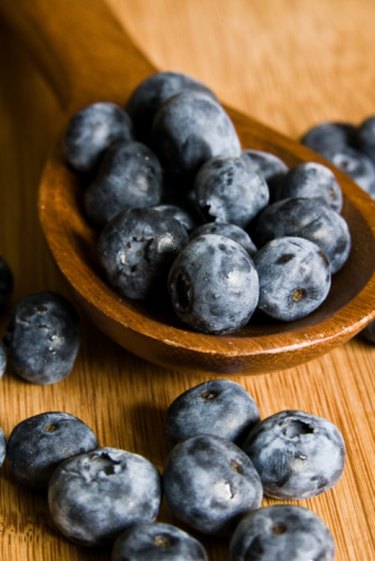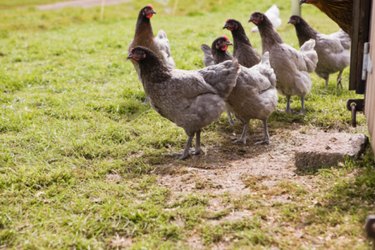
Blueberries are delicious and nutritious. They grow easily in home gardens and orchards. Planting and cultivating instructions are included with most plants, but you may need additional help if you find worms chowing down on your delicacies. Your first reaction may be to smash the little critter, but take an extra moment or two to identify the culprit and ascertain whether you need to take additional steps.
Wormy Consumers of Fresh Blueberries
Video of the Day

When you notice worms on your beautiful blueberries, take a moment to identify the enemy. Blueberries are susceptible to cranberry fruitworm, cherry fruitworm, stem borers and blueberry maggots. Identify cranberry fruitworm by its upper body coloring of brownish-red and its under body of green. It is usually about 1/2-inch long. Cherry fruitworms will appear a bright orange-red and are about 5/16-inch long. The blueberry maggot appears as a white 1/4-inch worm, which will mature to a small black fly with white markings. A stem borer is not easy to see. Look for this pest when new growth suddenly wilts. Examine the stem below the wilt for two encircling rows of punctures. Identifying the blueberry consumer will help with decisions regarding eradication.
Video of the Day
Prevention
Diligent attention to blueberry bushes will thwart these worms before they get a foothold. Always remove any visible pests and destroy them as quickly as possible. Pick off fruitworms by hand or use a forceful spray from a garden hose. Blueberry maggots infest the fruit and feed on it to maturity, so clean dropped berries from the ground to interrupt their life cycle. Monitor the population by trapping the flies. Traps can be made or purchased, and generally work better when painted a bright yellow-gold. Once painted, coat the surface with a sticky substance. Add Ammonium carbonate as an attractant. When stem borers are found, the stem tips must be cut below the puncture lines. Burn the trimmings to prevent re-infestation.
Post-Prevention Strategy

If preventive measures fail, take further action to prevent the loss of blueberry bushes. Cranberry fruitworm and cherry fruitworm may have an application of Bt (Bacillus thuringiensis, a natural soil dwelling bacteria that infects the pests) after 75 percent of the blossoms have dropped, and again in ten days. For blueberry maggots, disking or cultivating can bury infected berries, or off-season grazing by fowl can interrupt the life cycle. Rotenone and pyrethrum (chemical pesticides) may be applied according to directions. Check with county agriculture extension office for specific guidelines regarding pesticide use.
Resistant Species
Perhaps you have not yet planted your blueberries, and want a choice that will help avoid some of these issues. Studies have found that the early varieties of blueberries avoid the heaviest production phase of the blueberry maggot's life cycle. Choosing hybrid varieties as Bluetta or Earliblue can help, but likely will not prevent all worm infestations.